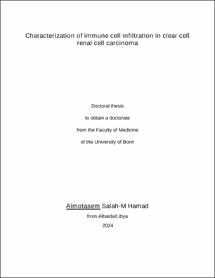Hamad, Almotasem Salah-M: Characterization of immune cell infiltration in clear cell renal cell carcinoma. - Bonn, 2024. - Dissertation, Rheinische Friedrich-Wilhelms-Universität Bonn.
Online-Ausgabe in bonndoc: https://nbn-resolving.org/urn:nbn:de:hbz:5-74196
Online-Ausgabe in bonndoc: https://nbn-resolving.org/urn:nbn:de:hbz:5-74196
@phdthesis{handle:20.500.11811/11262,
urn: https://nbn-resolving.org/urn:nbn:de:hbz:5-74196,
author = {{Almotasem Salah-M Hamad}},
title = {Characterization of immune cell infiltration in clear cell renal cell carcinoma},
school = {Rheinische Friedrich-Wilhelms-Universität Bonn},
year = 2024,
month = jan,
note = {Studying the immune system response to cancer has always been a massively investigated field. As the renal cell carcinoma (RCC) is considered a highly immunologic tumor, investigating the immune response and the nature of the tumor infiltrating immune cells (TIICs) in RCC holds strong importance. The tumor microenvironment contains different amount of special immune cell subtypes. In the present study we will investigate the tumor infiltration through the T lymphocytes, the B lymphocytes, the natural killer cells and the macrophages by immunohistochemistry with the following surface markers: CD3, CD4, CD8, CD20, CD56, CD68 and CD103.
The aim of the study was to characterize the immune cell infiltration in clear cell renal cell carcinoma (ccRCC) and its distant metastases according to clinico-pathological characteristics.
Formalin-fixed, paraffin embedded material from 50 primary ccRCC tumors and 22 corresponding metastases were involved in this study.
We could show that the intratumoral and peritumoral immune cell infiltration is not affected by tumor stage in ccRCC, but the tumor grading was inversely associated with the amount of different subtypes of T-lymphocytes (CD4+ and CD8+). Regarding the infiltration with CD3+ cells, the peritumoral infiltration was significantly higher in the primary tumors of the M1 cases compared to M0 cases, but intratumoral tumor infiltration did not follow the same trend. We also found that B-cell infiltration inversely correlate with the occurrence of local lymph node metastasis. The absence of lymphovascular invasion was associated with higher peritumoral CD56 infiltration. The tissue resident memory CD103+ lymphocytes accumulate in lung metastases and the CD68+ macrophages accumulate in bone metastases in comparison with other metastatic sites. Surprisingly, CD56-positive RCCs showed less infiltration of B and T-lymphocytes.},
url = {https://hdl.handle.net/20.500.11811/11262}
}
urn: https://nbn-resolving.org/urn:nbn:de:hbz:5-74196,
author = {{Almotasem Salah-M Hamad}},
title = {Characterization of immune cell infiltration in clear cell renal cell carcinoma},
school = {Rheinische Friedrich-Wilhelms-Universität Bonn},
year = 2024,
month = jan,
note = {Studying the immune system response to cancer has always been a massively investigated field. As the renal cell carcinoma (RCC) is considered a highly immunologic tumor, investigating the immune response and the nature of the tumor infiltrating immune cells (TIICs) in RCC holds strong importance. The tumor microenvironment contains different amount of special immune cell subtypes. In the present study we will investigate the tumor infiltration through the T lymphocytes, the B lymphocytes, the natural killer cells and the macrophages by immunohistochemistry with the following surface markers: CD3, CD4, CD8, CD20, CD56, CD68 and CD103.
The aim of the study was to characterize the immune cell infiltration in clear cell renal cell carcinoma (ccRCC) and its distant metastases according to clinico-pathological characteristics.
Formalin-fixed, paraffin embedded material from 50 primary ccRCC tumors and 22 corresponding metastases were involved in this study.
We could show that the intratumoral and peritumoral immune cell infiltration is not affected by tumor stage in ccRCC, but the tumor grading was inversely associated with the amount of different subtypes of T-lymphocytes (CD4+ and CD8+). Regarding the infiltration with CD3+ cells, the peritumoral infiltration was significantly higher in the primary tumors of the M1 cases compared to M0 cases, but intratumoral tumor infiltration did not follow the same trend. We also found that B-cell infiltration inversely correlate with the occurrence of local lymph node metastasis. The absence of lymphovascular invasion was associated with higher peritumoral CD56 infiltration. The tissue resident memory CD103+ lymphocytes accumulate in lung metastases and the CD68+ macrophages accumulate in bone metastases in comparison with other metastatic sites. Surprisingly, CD56-positive RCCs showed less infiltration of B and T-lymphocytes.},
url = {https://hdl.handle.net/20.500.11811/11262}
}






